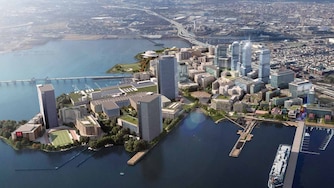Eastern Shore watermen harvested billions of oysters in the 1800s, so many that they used the shells to fill a Somerset County marsh. On top of them, the town of Crisfield sprouted into a home to 25,000 residents who called it the “Seafood Capital of the World.”
Today, a tenth as many people live there, and they face a slow-moving disaster.
Just 3 feet above sea level, the Eastern Shore town is disappearing into the Chesapeake Bay. Disasters like Superstorm Sandy in 2012 flooded Crisfield badly, forcing hundreds to evacuate and leaving behind tens of millions of dollars in damage.
Even without hurricane-driven surges and downpours, tides routinely flood the town’s roads on clear days, a phenomenon scientists expect will grow more common as the land sinks and seas rise. As soon as 2050, Crisfield could see widespread flooding every day at high tide.
Many there, though, haven’t accepted this fate.
For years, Crisfield’s leaders have charted their future under climate change, working with scientists to model new infrastructure that might save them. Their work paid off last summer when the Federal Emergency Management Agency awarded $36 million for phase one of a mammoth undertaking — to surround Crisfield with bulkheads, raised roads and absorbent wetlands.
At nine times Crisfield’s annual budget, FEMA’s down payment promised deliverance.
Routine flooding could inundate much of Crisfield soon
As climate change drives rising waters in the Chesapeake Bay, tidal flooding will become more common in Crisfield. Scientists expect waters could spread through much of Crisfield on a daily basis sometime between 2050 and 2080.
Current:Tide gates
Projected flooding: 2.5-foot flood
Flooding stopped by current measures
Then, in April, the government went back on its word. President Donald Trump’s administration canceled the grant and eliminated the FEMA program. The decision dashed Crisfield’s hopes of tapping tens of millions more for its flood plan, and leaves an area deeply loyal to Trump to bear the weight of his climate denialism.
If the water overtakes Crisfield, some may stay. But many more wonder: Is a community that experiences costly floods every day still a community?
Mayor Darlene Taylor doesn’t think so. The Crisfield native felt called by God to run for mayor in 2022, though she admits she didn’t understand the ramifications of sea level rise then. Now, protecting her hometown is part of her mission.
“We will not be here if we don’t have a major intervention,” said Taylor, a Democrat. “That’s it.”



‘It’s bleak’
Crisfield residents need only look across Tangier Sound at the bay’s disappearing islands to glimpse their sinking future.
A combination of erosion and rising waters have eaten away at Tangier and Smith islands, a short ferry ride from Crisfield. To the north, Deal Island is disappearing from the inside out. Holland Island is already gone.
“It’s bleak,” said Rev. Emanuel Johnson, who until this month led Shiloh United Methodist Church in Crisfield. “They see it happening.”
Johnson’s own baptism in the floods came early. A few months after his 2021 appointment in Crisfield, high water outside Shiloh ruined his Cadillac.
“No one called me to tell me to move my car to higher ground,” he said. “Now, they call me.”
Scientists tracking Crisfield’s flood challenges found that it experienced tidal flooding from 1.5-foot sea level surges on 88 days in 2021. In the last three years, flooding has cancelled or delayed county schools on 12 days, according to Taylor, something the mayor doesn’t remember happening at all when she was a kid.


Things could get worse soon.
The research team, a joint-effort of the University of Maryland, George Mason University and the Nature Conservancy, expect that sometime between 2050 and 2080, Crisfield will experience tidal flooding to 2.5 feet every day.
Such flooding would spread through much of the town, and, according to their modeling, the costs would be untenable: Each 2.5-foot flood incident could leave as much as $2.7 million in damages.
Once home to nearly two dozen crab-picking houses, Crisfield’s economic fortunes have fallen with the Chesapeake seafood industry. The last crab-picking house in town is for sale, with an uncertain future. The population has waned, and average household income is less than $50,000 — half that of Maryland as a whole.
By canceling the FEMA grant, Trump undercut help for some of his own supporters. More than half of surrounding Somerset County supported Trump in each of the last three presidential elections. Almost 60% of voters in Crisfield’s precinct backed Trump last year.



“It’s a rural, conservative community that really needs this,” said Jennifer Merritt, former grants manager for Crisfield who oversaw its FEMA application. “It needs this project for its economic future, and it needs this project to keep the community a community.”
FEMA did not respond to requests for comment. In response to an inquiry earlier this year after it ended the program, known as Building Resilient Infrastructure and Communities, the agency reiterated a statement, since removed from its website, that the grants were “yet another example of a wasteful and ineffective FEMA program.”
“It was more concerned with political agendas than helping Americans affected by natural disasters,” the FEMA press office said.
Johnson makes his liberal politics clear from the pulpit and counted the mayor among his parishioners. Asked whether Crisfield could survive without the FEMA money, the pastor hesitated.

Residents are learning to live with flooding, he said. Some are modifying and elevating their homes.
But he wondered: “Is Crisfield just going to be a former memory? I don’t know.”
To save the town
When a few dozen Crisfield residents and scientists gathered at the community library in April, the mayor acknowledged the lost money only briefly. The crowd was there for the last session of the “Crisfield Resilience Academy,” an EPA initiative to educate residents and involve them in building a community that could withstand rising waters.
Taylor said she was devastated but not surprised by the decision, and told attendees that Crisfield won’t be deterred. Leaders will explore options for new funding, she said.
The survival strategy is simple, if expensive: Erect sea walls, which combined with flood berms, raised roads, restored wetlands, pumps and tide gates, would protect the town from up to 5 feet of sea level rise — higher even than Sandy’s surge.



The enclosure would wrap southern Crisfield first. A second phase would protect north Crisfield. The whole project would cost nearly $80 million, targeted for completion in early 2031.
Even if FEMA reinstated funding or Crisfield cobbled together money from other sources, the town would be playing catch-up.
“They needed help on flooding decades ago in Crisfield,” said Stephanie Dalke, a program manager at the University of Maryland’s Environmental Finance Center who worked on the Crisfield flood study.
Still, some in Crisfield aren’t convinced they need the money.
Two longtime watermen, Randall Burke and Jack Swift, were loading a truck at the Crisfield docks one recent afternoon.
Burke, 57, hadn’t heard about the FEMA award, but said it sounded “nice to have.” Swift, 52 and wearing a red “TRUMP WAS RIGHT” hat, wasn’t so sure. He said he doesn’t trust town leaders to responsibly manage the money.
Eventually, both agreed Crisfield can get by on its own. People have learned to live with flooding, the two watermen said, and when the tide is high, they know which roads to avoid.
Even as Crisfield leaders search for ways to ward off sea level rise, they may not be able to protect everyone. The FEMA-backed plan would extend less than a mile inland from Main Street, leaving areas farther east and beyond the town limits at risk.


Mike Banning bought a small cottage a few years ago for $20,000 in one such area east of town, unaware of the flooding.
Since then, he’s tried to fortify it by spreading loads of sand around the foundations. The floodwaters sometimes reach his doorstep. If someone had warned him, Banning said, he may not have bought the place.
Now he wants to leave.
Political realities
The person who might have the best shot at reversing the Trump administration decision is Crisfield’s congressman, Rep. Andy Harris.
As chair of the right-wing Freedom Caucus on Capitol Hill, Harris holds significant sway among Washington Republicans. A self-described fiscal hawk, his opinion on Eastern Shore flood prevention isn’t clear. While the congressman has asked for more money for his district than any of his Maryland colleagues, including $1.4 million for a new Crisfield fire station, none of his requests for the next budget address the town’s flood prevention needs.
Harris’s office did not respond to multiple requests for comment.
In a statement to the Chesapeake Bay Journal in May, Harris’ office pointed out that he wrote a letter endorsing Crisfield’s original application for FEMA funding and said he remains “supportive of the city’s need to become more safe, resilient and prosperous by reducing the negative impacts of flooding.”

Taylor, too, heard from Harris’ team after the cancellation, expressing support.
Mary and Danny Nelson had a bird’s-eye view of Sandy’s destruction in 2012, when they were flooded out of their waterfront apartment. Since then, they’ve moved across Main Street to a spot at the end of the reconstructed pier. The home adjoins the couple’s restaurant, Water’s Edge Cafe, and its windows frame sunsets over the bay.
Steadfast Trump supporters, the Nelsons believe these deep budget cuts serve a greater good, even if it comes at their expense. Sometimes you have to look at the bigger picture, Mary Nelson said.
She doesn’t worry about what it could mean for her home.
“I am gifted something that someone else built a long time ago with oyster shells. And I get a beautiful view,” she said. “And there is a price to pay for it.”






Comments
Welcome to The Banner's subscriber-only commenting community. Please review our community guidelines.